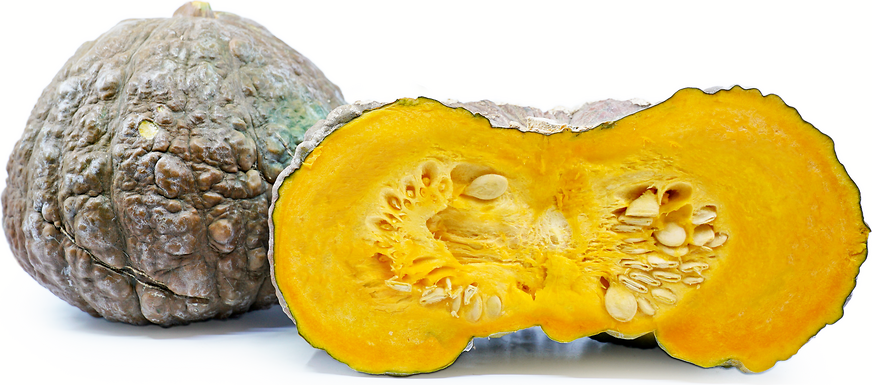


Marina di Chiogga Squash
Estimated Inventory, lb : 0
Description/Taste
Marina di Chioggia squash is medium to large in size, averaging 10-12 pounds in weight, and is round, short, and squat in shape. The dark green to gray-blue skin has slight, vertical ridging and is almost completely covered in bumps known as sugar warts, which are created from the buildup of extra sugars in the squash’s skin and flesh. When mature, the skin will be hardened to the point that it cannot be dented with a fingernail and the stem at the cap will be rough, rigid, and brown. The thick, dense, and dry, yellow-orange flesh surrounds a semi-hollow fibrous cavity with many large, flat, cream-colored seeds. When cooked, Marina di Chioggia squash is tender and sweet with nutty flavors.
Seasons/Availability
Marina di Chioggia squash is available in the fall through winter.
Current Facts
Marina di Chioggia, botanically classified as Cucurbita maxima, is an Italian heirloom variety that is a member of the Cucurbitaceae family along with pumpkins and gourds. Also known as the Chioggia Sea pumpkin, Marina di Chioggia comes from the Italian seaside village of the same name, Chioggia. Its Venetian nicknames include Zucca Barucca and Zucca Santa, which translates to mean holy pumpkin. A common squash in Italy, it is found at markets, and farm stands when in season and is still sold as a popular street food by vendors along the canals of Venice prepared simply sliced, grilled, and salted.
Nutritional Value
The orange flesh of Marina di Chioggia is known to be high in beta-carotene which provides not only a valuable nutrient but also is responsible for the squash's vibrant coloring.
Applications
Marina di Chioggia is best suited for cooked applications such as roasting, baking, steaming, and grilling, and can be utilized in recipes wherever traditional pumpkin is called for. The skin can be removed before cooking or after, depending on preference, and the squash can be added to risotto, minestrone, sauces, and stews. Diced and roasted squash will complement warm salads, pasta preparations, or can be used as a topping for flatbreads. When cooked and pureed, the Marina di Chioggia makes an ideal filling for ravioli, tortellini, and can be added to gnocchi batter. It is also known to be an excellent dessert pumpkin and can be used in pies, tarts, muffins, and quick bread. Marina di Chioggia pairs well with fennel, eggplant, radicchio, kale, onion, garlic, rosemary, basil, pine nuts, raisins, cinnamon, coriander, mustard powder, vinegar, sea salt, olive oil, and parmesan cheese. It will keep up to six months when stored in a cool, dry, and dark place. It should be noted that the shelf life will be prolonged as long as the stem stays intact. If it should fall off, the shelf life of the squash will be shortened significantly.
Ethnic/Cultural Info
Marina di Chioggia has long been a staple squash in Venice, Italy where it is also known as Suca Braca, or warty pumpkin, in the Venetian dialect. It is mentioned in the play Le Baruffe Chiozzotte, written by the eighteenth-century playwright, Carlo Goldoni and depicts the townspeople of Chioggia fighting over the squash. The cooked squash was traditionally sold by street hawkers who would walk through the town, carrying wooden planks on their shoulders piled high with hot roasted squash. Marina di Chioggia squash is a signature ingredient in regional dishes such as gnocchi zucca and Venetian tortellini. It is also used in the traditional dish of saor de suca baruca or sweet and sour pumpkin which consists of Marina di Chioggia combined with white onions, pine nuts, raisins, white wine, and vinegar. A culinary hub, Chioggia and the Veneto region are famous for their seafood and squash as well as for a handful of famous radicchios such as castelfranco, treviso, chiogga, and verona.
Geography/History
Squash of Cucurbita maxima are believed to have made their way to Italy via explorers returning to Spain from South and Central America. By the late 1600s, the unique looking Marina di Chioggia was known as a Venetian squash, and its name was given after the seaport fishing village of Chioggia at the southern tip of Venice where it has long been popularly grown and sold. Due to its limited exposure and lack of demand outside of Italy, the Marina di Chioggia has not experienced the grand commercial success of other squash varieties. Today it can be found throughout Europe and the United States on online seed catalogs, grown by heirloom specialty growers, and for home garden use.
Recipe Ideas
Recipes that include Marina di Chiogga Squash. One
| Clear-Conscience Comfort Food |
|
Roasted Marina di Chioggia Pumpkin |
| Gobo Root |
|
Winter Squash Soup |




